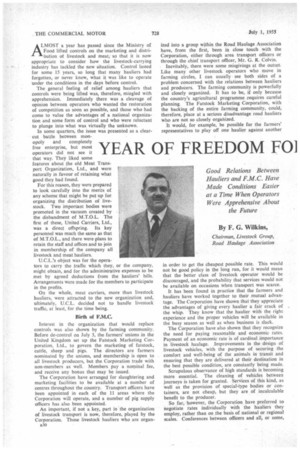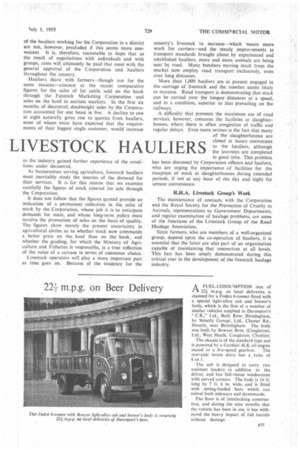YEAR OF FREEDOM FO] LIVESTOCK HAULIERS
Page 56

Page 57

If you've noticed an error in this article please click here to report it so we can fix it.
ALMOST a year has passed since the Ministry of Food lifted controls on the marketing and distribution of livestock and meat; so that it is now appropriate to consider how the livestock-carrying industry has tackled the new situation. Control lasted for some 15 years, so long that many hauliers had forgotten, or never knew, what it was like to operate under the conditions in the days before control.
The general feeling of relief among hauliers that controls were being lifted was, therefore, mingled with apprehension. Immediately there was a cleavage of opinion between operators who wanted the restoration of competition as soon as possible, and those who had come to value the advantages of a national organization and some form of control and who were reluctant to plunge into what was virtually the unknown.
In some quarters, the issue was presented as a clearcut battle between monopoly and completely free enterprise, but most operators did not see it that way. They liked some features about the old Meat Transport Organization, Ltd., and were naturally in favour of retaining what good they had found.
For this reason, they were prepared to look carefully into the merits of any scheme that might be put up for organizing the distribution of livestock. Two important bodies were promoted in the vacuum created by the disbandment of M.T.O.L. The first of these, United Carriers, Ltd., was a direct offspring. Its key personnel was much the same as that of M.T.O.L., and there were plans to retain the staff and offices and to join in membership of the company all livestock and meat hauliers.
U.C.L.'s object was for the operators to carry the traffic which they, or the company, might obtain, and for the administrative expenses to be met by agreed deductions from the hauliers' bills. Arrangements were made for the members to participate in the profits.
On the whole, meat carriers, more than livestock hauliers, were attracted to the new organization and, ultimately, U.C.L. decided not to handle livestock traffic, at least, for the time being.
Birth of F.M.C.
Interest in the organization that would replace controls was also shown by the farming community. Before de-control on July 3, the farmers' unions in the United Kingdom set up the Fatstock Marketing Corporation, Ltd., to govern the marketing of fatstock, cattle, sheep and pigs. The directors are farmers nominated by the unions, and membership is open to all livestock producers, but the Corporation trade with non-members as well. Members pay a nominal fee, and receive any bonus that may be issued.
The Corporation have arranged for slaughtering and marketing facilities to be available at a number of centres throughout the country. Transport officers have been appointed in each of the 11 areas where the Corporation will operate, and a number of pig supply officers has also been appointed.
An important, if not a key, part in the organization of livestock transport is now, therefore, played by the Corporation. Those livestock hauliers who are organ a30 ized into a group within the Road Haulage Association have, from the first, been in close touch with the Corporation, either through area transport officers or through the chief transport officer, Mr. G. R. Colvin.
• Inevitably, there were some misgivings at the outset. Like many other livestock operators who move in farming circles, I can usually see both sides of a problem concerned with the relations between hauliers and producers. The farming community is powerfully and closely organized. It has to be, if only because the country's agricultural programme requires careful planning. The Fatstock Marketing Corporation, with the backing of the entire farming community, could, therefore, place at a serious disadvantage road hauliers who are not so closely organized.
It would, for example, be possible for the farmers' representatives to play off one haulier against another in order to get the cheapest possible rate. This would not be good policy in the long run, for it would mean that the better class of livestock operator would be discouraged, and the probability that services would not be available on occasions when transport was scarce.
It has been found in practice that the farmers and hauliers have worked together to their mutual advantage. The Corporation have shown that they appreciate the advantages of giving every haulier a fair crack of , the whip. They know that the haulier with the right experience and the proper vehicles will be available in the busy season as well as when business is slack.
The Corporation have also shown that they recognize the need for paying reasonable and economic rates. Payment of an economic rate is of cardinal importance in livestock haulage. Improvements in the design of livestock vehicles, with the purpose of securing the comfort and well-being of the animals in transit and ensuring that they are delivered at their destination in the best possible condition, are constantly being made.
Scrupulous observance of high standards is becoming more essential. The cleaning of vehicles between journeys is taken for granted. Services of this kind, as well as the provision of special-type bodies or containers, are not cheap, but they are of incalculable benefit to the producer.
So far, however, the Corporation have preferred to negotiate rates individually with the hauliers they employ, rather than on the basis of national or regional scales. Conferences between officers and all, or some,
of the hauliers working for the Corporation in a district are not, however, -precluded if this seems more convenient. It is, therefore, reasonable to hope that as the result of negotiations with individuals and with groups, rates will ultimately be paid that meet with the general approval of the Corporation and hauliers throughout the country.
Hauliers share with farmers—though not for the same reasons—concern at the recent comparative figures for the sales of fat cattle sold on the hook through the Fatstock Marketing Corporation and sales on the hoof in auction markets. In the first six months of decontrol, deadweight sales by the Corporation accounted for one beast in five. A decline to one in eight naturally gives rise to queries from hauliers, most of whom must have expected that the requirements of their biggest single customer, would increase as the industry gained further experience of the conditions under decontrol.
As businessmen serving agriculture, livestock hauliers must inevitably study the sources of the demand for their services. It is for this reason that we examine carefully the figures of stock entered for sale through the Corporation.
It does not follow that the figures quoted provide an indication of a permanent reduction in the sales of stock by the Corporation, whose job it is to anticipate demands for meat, and whose long-term policy must involve the promotion of sales on the basis of quality. The figures show merely the present uncertainly in agricultural circles as to whether stock now commands a better price on the , hoof than on the hoc*, and whether the grading, for which the Ministry -of Agriculture and Fisheries is responsible, is a true reflection of the value of a carcase in terms of consumer choice.
Livestock operators will play a more important part as time goes on. Because of the tendency for the
country's livestock to increase—which means more work for carriers—and the steady improvements in transport standards brought about by experienced and established hauliers, more and more animals are being sent by road. Many butchers moving stock from the market now employ road transport exclusively, even over long distances.
More than 1,000 hauliers are at present engaged in the carriage of livestock and the number seems likely to increase. Road transport is demonstrating that stock can be carried over the longest distances at a speed, and in a condition, superior to that prevailing on the railways.
A difficulty that prevents the maximum use of road services, however, concerns the facilities at slaughterhouses, where there is often congestion of traffic and regular delays. Even more serious is the fact that many of the slaughterhouses are closed at hours convenient to the hauliers, although the journeys are completed in good time. This problem has been discussed by Corporation officers and hauliers, who are urging the importance of facilities for the reception of stock at slaughterhouses during extended periods, if not at any hour of the day and night for utmost convenience.
R.H.A. Livestock Group's Work
The maintenance of contacts with the Corporation and the Royal Society for the Prevention of Cruelty to Animals, representations to Government Departments, and regular examination of haulage problems, are some of the functions of the Livestock Group of the Road Haulage Association.
Since farmers, who are members of a well-organized group. depend upon the co-operation of hauliers, it is essential that the latter are also part of an organization capable of maintaining that connection at all levels. This fact has been amply demonstrated during this critical year in the development of the livestock haulage industry.
A FUEL-CONSUMPTION rate of
rt 224 m.p.g. on local deliveries is claimed for a Foden 6-tonner fitted with a special light-alloy cab and brewer's body, which is the first of a number of similar vehicles supplied to Davenport's " C.B.," Ltd., Bath Row, Birmingham, by Streetly Garage, Ltd., Chester Rd., Streetly, near Birmingham. The body was built by Bowyer Bros. (COngleton), Ltd., West Heath. Congleton, Cheshire.
The chassis is of the standard type and is powered by a Gardner 4LK oil engine mated to a five-speed gearbox. The rear-axle worm drive has a ratio of 6 to 1.
The cab is designed to carry two assistant loaders in addition to the driver, and has full-visionwindscreens with curved corners. The body is 16 ft. long by 7 ft. 6 in. wide, and is fitted with spring-loaded bars which can swivel both sideways and downwards.
The floor is of interlocking construc tion, and during the nine months that the vehicle has been in use, it has withstood the heavy impact of full barrels without damage.












































































































































